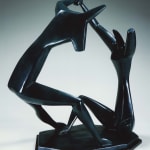




Alexander Archipenko
Further images
Conceived in plaster in 1912-13/1959 and cast in bronze under the direction of Frances Archipenko Gray at Sheidow Foundry in an edition of nine, four of which were posthumous casts. The present work is number FA/V.3 from the edition and was cast in 1964. It is recorded in the Archipenko Foundation under no. 2945.
This composition exists in three versions. The first was conceived in plaster in 1912-13, with a later bronze cast in 1922 (known as version A). Two additional plasters (known as version B (V.3) and version C (V.2)), based on the original 1912-13 variation, were conceived in 1959 with additional bronze versions later cast. The present work belongs to version B (V.3). Alexander Archipenko first arrived in Paris from his native Kyiv in 1909. Dissatisfied with the academic training of the École des Beaux-Arts, he established an art studio in Montparnasse where he met Modigliani, Léger, Apollinaire, and other like-minded artists from the avant-garde circles. By 1910, he was participating in the Salon des Indépendants and a year later in the Salon d’Automne with the Cubists.
In 1912, Archipenko created the original plaster for Dance, which currently resides at the Saarlandmuseum in Saarbrücken, Germany. While living in Paris, he would have seen Matisse’s painting, La Danse, 1910, which Dance bears a striking similarity to in both subject matter and form. Archipenko’s radical experimentation with simplified geometric forms and their ability to exist in multiple dimensions contributed to the canon of Cubism and pushed the boundaries of sculpture.




